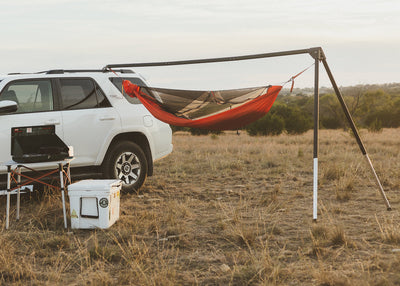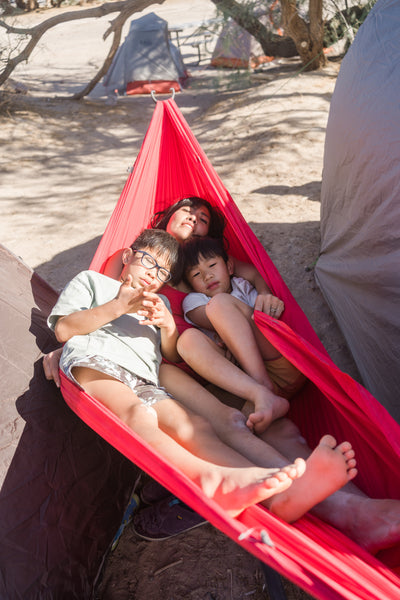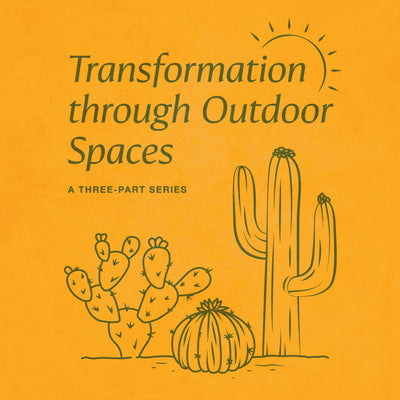Adventure gift guide 2017
Give experiences they'll remember forever with gear that stands the test of time. We're here to make you the most famous gift-giver in your family this holiday–here are a few of our favorite things this season.

Give experiences they'll remember forever with gear that stands the test of time. We're here to make you the most famous gift-giver in your family this holiday–here are a few of our favorite things this season.


The universal mount included with every Outpost is designed to be compatible with a wide variety of roof racks. What's Included: 1 detachable ball bracket 2 clamp plates 2 bolts for ball bracket 2 hex nuts for ball bracket 2 t-slot nuts 4 clamp plate bolts 4 hex nuts for clamp plates 2 foam pads for clamp plates Cross Bar Compatibility The image below shows how the universal mount is assembled for cross bar compatibility. This assembly utilizes all of the included parts except for the 2 t-slot nuts. Outpost is designed to mount to all standard cross bars as seen in the following image: Need more rack space? Outpost is designed to work with the universal mount attached on the underside of cross bars as well: T-Slot Compatibility The next image shows how the universal mount is assembled for t-slot compatibility. This assembly utilizes the detachable ball bracket, 2 bolts, and 2 t-slot nuts. Outpost easily mounts to your rack's t-slots as seen in this image: Additional Mounting Options The universal mount can also attach to these style racks using the two clamp plates: Platform-Style Racks Basket-Style Racks Truck Bed Cargo Racks Custom Mounting Additionally, the Outpost universal mount can be custom mounted to a variety of racks using the detachable ball bracket as seen below: Questions? For more information on how Outpost can attach to your vehicle, please reach out to us here.

Every National Camp at Home Day celebration needs tasty refreshments. We think this one's a crowd pleaser for sure. Learn more about how you can make the most of your camp at home celebration here. Ingredients: Vodka 2-3 Grapefruits Sparkling Water Sugar Kosher or Sea Salt Fresh Rosemary Preparation: Juice your grapefruits until you get 1/4 cup of juice. Pour juice into a sauce pan and add 2 tablespoons of sugar. Turn burner on low heat and let simmer until all the sugar is dissolved. Prep your favorite rocks glass by rimming it with salt and filling it with ice. Add 2 ounces of vodka to your cup. Add the grapefruit and sugar mixture to your cup. Top it off with sparkling water. Garnish with a slice of grapefruit and rosemary sprig. National Camp at Home Day is all about one thing: outdoor relaxation. What that means to you could be completely different for someone else. Whether you feel inspired to go on an afternoon jog, set up your tent in the back yard, or just spend an hour reading in your hammock, we hope you'll make the most of it. And if you need one more way to maximize your relaxation vibes, the official cocktail of National Camp at Home Day is here to deliver. Are you celebrating National Camp at Home Day in the Austin area? Drop by our gear shop for a hassle-free, ready-to-drink canned cocktail from All Hands that's sure to put you in the right mindset when the 27th rolls around. Sure, you can spend the extra time to make it yourself, but with a canned cocktail this good, why would you? Cheers, y'all!

Mother’s Day is right around the corner, and here at Kammok, we want to give it up for all the adventure moms out there. But what is an adventure mom? This title isn’t reserved for the women strapping their toddler to their back for a 14er in the Rockies, although these awesome moms are definitely included. Adventure isn’t exclusive to national parks and backcountry trails—it happens every day when people step unknowingly into something new and exciting. Motherhood itself is one of the greatest adventures of all, marked with thrilling summits and impressive finish lines. We put this gift guide together to help you celebrate all the moms in your life, hopefully with something to make the adventure a bit more enjoyable. Photo by @EverydayAdventureFam. Kammok Swiftlet: For the mom who needs some me-time. What hardworking mom doesn’t deserve a break from the hectic day to day? The Swiftlet Portable Hammock Stand is exactly what she needs to kick back and relax in her own quiet space—trees optional. At only 15 pounds, the Swiftlet can pack up and go anywhere, from her indoor reading nook to her favorite beach access. And when she’s ready for company, the Swiftlet's 300-pound weight capacity makes it the perfect place at camp for a snuggle sesh. The Swiftlet can be used in sit mode or lounge mode making it a great option for soccer moms who need a comfortable chair for game day as well as a nap spot for a midday break. Combine the Swiftlet with any of our Roo hammocks for a go-anywhere oasis your mom will love. BioLite HeadLamp 200: For the busy mom. Let’s get real—all moms are busy. Whether they’re working long hours, taking care of the kids, or running around town tackling their to-do list, moms’ days are jam packed. The BioLite HeadLamp 200 extends the time our active moms can spend outside, lighting the path for a predawn hike or shining bright for a night jog on the trail. The rechargeable battery lasts up to 40 hours which means no more buying and throwing away alkaline batteries. Plus, the 3D Slimfit Construction provides for a near-weightless feel, making it the most comfortable headlamp for any occasion. The BioLite HeadLamp 200 is the perfect upgrade for any outdoor mom’s kit. Photo by @JayKolsch. Osprey Arcane Tote Pack: For the mom who needs an extra hand. If your mom leaves the house every day with both hands full and something tucked under each arm, it’s time to upgrade her to the Arcane Tote Pack. The tuckaway straps make it easy to switch from backpack mode to tote mode, so whether she’s headed to the office or going out for a quick hike, this bag will keep up. The Tote Pack features a laptop sleeve, internal organization, a scratch-free zipper pocket for her phone or sunglasses, and an external shove-it pocket for quick access to essentials. Lastly, the durable fabric is made from recycled plastic bottles, making the Arcane Tote Pack a sustainable choice for your mom’s new favorite everyday bag. Forsake Meridian: For the mom on the go. Just like the moms in our life, these shoes can do it all. The Meridian’s slip-on stretch collar makes getting out the door a cinch, and the Peak-to-Pavement Outsole promises she’ll be ready wherever the adventure leads. These shoes are super breathable while maintaining rugged durability, meaning they’re built for all-day comfort and the abuse that comes with excessive wear. Put it this way: She’s never going to want to take these off. And for the travel moms who want to pack light, this stylish shoe will take her everywhere—from the airport to a day of sightseeing and back again. The Forsake Meridian is going to be her new do-it-all shoe. United by Blue, The Container Kit: For the snack mom. Moms have been keeping us happy and fed since day one. They have a knack for sensing when we’re about to get cranky and have expert timing for handing over a juice box or cheese puff. The Container Kit from United by Blue is essential for any mom taking snacks on the go. This high-performance lunch box sports fabric made from recycled plastic bottles, and it’s just as durable and stain resistant as it is environmentally friendly. The kit includes two stainless steel, double-insulated containers that can keep hot things hot for up to 12 hours and cold things cold for up to 24 hours. Whether she’s feeding her little ones or heading to the park for a solo lunch, The Container Kit is a must have for our nurturing moms.

Our outdoor community is built upon adventure seekers. While sometimes this means spending time in harsh weather and challenging ourselves physically, other times it means having difficult conversations and changing our perspective. In this three-part series on The Outpost, we will share the stories of individuals redefining what it means to be outside. Written by Luisa Vargas. As a first-generation immigrant from Colombia, I was lucky enough to have parents who taught me the value of spending time in nature. However, the first time a friend called me “outdoorsy” I thought it couldn’t be true. I didn’t look like anyone who shopped at REI. Growing up, I was an artistic kid, not an athletic one. I’m afraid of heights and I’m brown. Little did I know I was fed the same story as most people: That to identify as outdoorsy, you have to spend time outside doing physically draining activities like multi-day hiking trips, climbing up giant rocks or kayaking through rough waters. And that you’re white. It took years to finally consider myself an outdoor enthusiast. Looking back, I realize I was just as outdoorsy then as I am now, but I kept wondering why it took me so long to realize this. To explore that question, I talked with three incredible adventurers who defy the mainstream standards of being outdoorsy. Over the next few weeks, I’ll be sharing their stories. The first story is from Rocío, a trail runner, social justice advocate, mentor and native Austinite. Although we barely scratch the surface, these are thirst-quenching conversations that reexamine how we ask questions about diversity in outdoor spaces. They share their journey of transformation in the outdoors and talk about how we can cultivate inclusive spaces that honor history and tradition. Rocío Villalobos at Caprock Canyon State Park When I first talked with Rocío Villalobos over Zoom, I instantly felt calming energy. As an avid trail runner, she spends a copious amount of time outside, but her true gift is blending her outdoor experiences with a commitment to social justice. She currently works in the city of Austin’s Equity Office as an Immigrant Affairs Coordinator and has experience working with various environmental and social justice organizations including PODER (People Organizing in Defense of the Earth and Her Resources). Rocío shares that her great grandparents were indigenous people from tribes in what we now call Mexico. Reconnecting with the land and her ancestors is one of the many reasons she finds spending time outside so impactful. “My grandparents learned it was worth assimilating into this broader Mexican identity rather than holding onto their customs. For me, a part of going outside is reconnecting with the land and my ancestors,” Rocío says. As we explore the reasons why she values spending time outside, she describes how simply having the time to be in nature is a privilege. Growing up, Rocío wasn’t outside much. Her parents worked long hours and were worried about allowing their kids to wander alone. It wasn’t until she was an adult and faced depression that she turned to running as one of her remedies. “It made me feel confident and shifted some of the internal talk that I know was really negative,” Rocío says. Rocío participating in a trail race As Rocío continued finding joy in outdoor spaces while doing social justice work, the two began merging. She worked in various environmental organizations and began mentoring girls with Explore Austin where she finds an opportunity to connect with young women who are developing their own connection to the land. Mentorship is a big part of Rocío's life. She’s continually sharing resources and adventure gear with people who want to spend more time outside, particularly women of color. When I asked Rocío why we don’t see more women of color in traditional outdoor spaces despite the growing interest, her answer was transformative. Rocío suggests that instead of asking why we don’t see certain groups outside, we should be asking if communities are already spending time outdoors in ways that don’t fit the mainstream idea of what we think as outdoor time. Spending time outside could be something as simple as preparing your soil for a garden or hanging in a hammock listening to the birds. She describes the popular vision of the outdoors as, “Feeling like an almost hypermasculine idea,” where you have to do something physically draining. According to Rocío, there is value in trying new, challenging things, but this doesn’t have to be the only way we enjoy the outdoors. The goal should be connecting to the land, and that’s going to look different for everyone. As we begin addressing inclusivity in these spaces, it’s important to remember we’re not here to force change upon people. Rocío says the bigger questions are, “What do our institutions look like? What have they done to create barriers or opportunities to get to spend time in certain places?” Addressing institutional change is an important part of racial equity work everywhere, not just in outdoor spaces. Many times institutions are out of touch with what is happening in their own communities and that becomes another layer of the problem. She explains that social inequities are hundreds of years old and are going to take just as long to undo. “Find a balance of being grounded in reality but still holding onto that hope of transformation,” Rocío says. I believe Rocío excels at racial equity work and ultramarathons because both require preparation and endurance for a long and difficult path while still believing transformation is possible. Redefining what it means to identify as an outdoorsy person will open doors for people to benefit from the transformative power of being outside, despite the restrictions placed by mainstream ideas. Next time you catch yourself wishing you had more time to spend outside, remember that your backyard and your hammock are waiting. Here you can explore some ideas on spending more time outdoors. “How is this helping me develop a deeper relationship with the land? That’s what our goal should be.” -Rocío Villalobos Organizations Rocío has worked with: Austin Racial Equity Office PODER The University of Texas Multicultural Engagement Center Explore Austin Other organizations and companies supporting diversity in the outdoors: Black Outside Native Women’s Wilderness Tawa Threads Latinos Outdoors